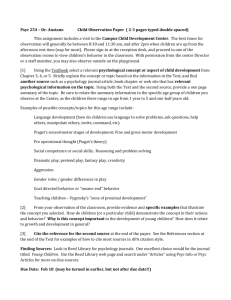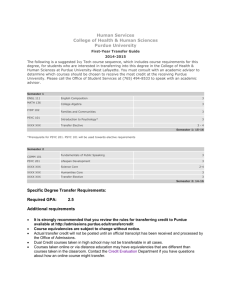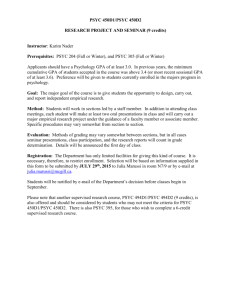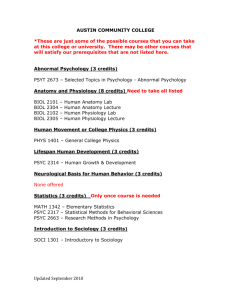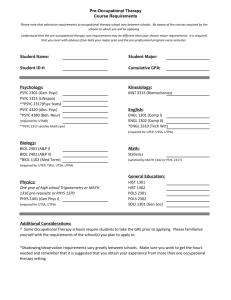Part B - Governance
advertisement
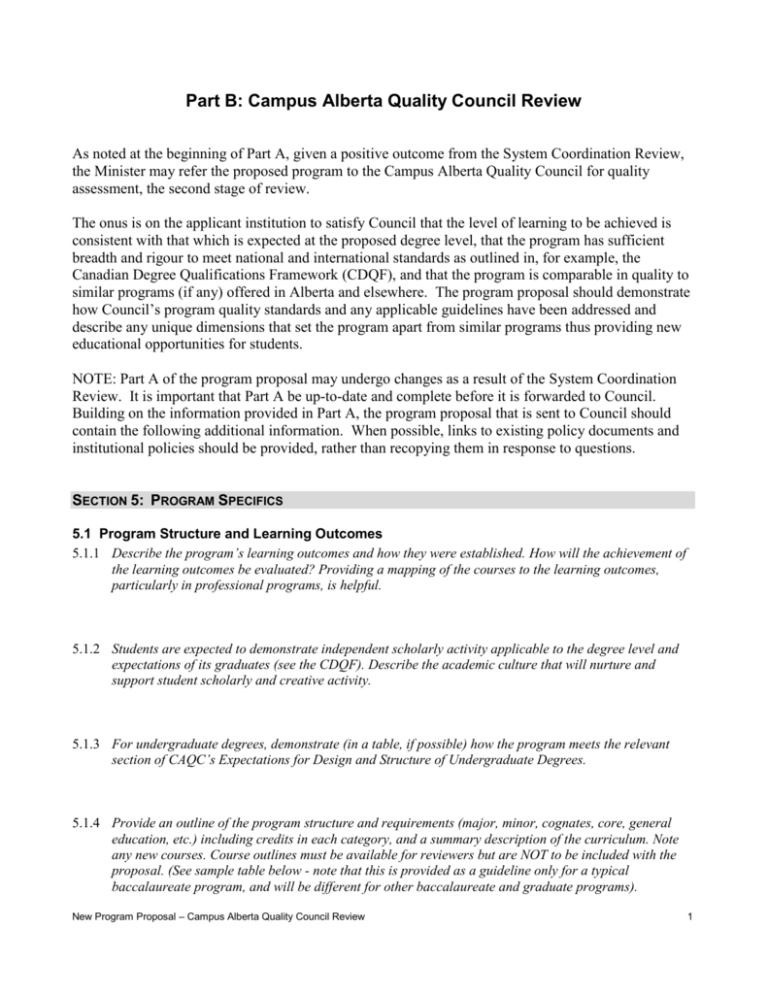
Part B: Campus Alberta Quality Council Review As noted at the beginning of Part A, given a positive outcome from the System Coordination Review, the Minister may refer the proposed program to the Campus Alberta Quality Council for quality assessment, the second stage of review. The onus is on the applicant institution to satisfy Council that the level of learning to be achieved is consistent with that which is expected at the proposed degree level, that the program has sufficient breadth and rigour to meet national and international standards as outlined in, for example, the Canadian Degree Qualifications Framework (CDQF), and that the program is comparable in quality to similar programs (if any) offered in Alberta and elsewhere. The program proposal should demonstrate how Council’s program quality standards and any applicable guidelines have been addressed and describe any unique dimensions that set the program apart from similar programs thus providing new educational opportunities for students. NOTE: Part A of the program proposal may undergo changes as a result of the System Coordination Review. It is important that Part A be up-to-date and complete before it is forwarded to Council. Building on the information provided in Part A, the program proposal that is sent to Council should contain the following additional information. When possible, links to existing policy documents and institutional policies should be provided, rather than recopying them in response to questions. SECTION 5: PROGRAM SPECIFICS 5.1 Program Structure and Learning Outcomes 5.1.1 Describe the program’s learning outcomes and how they were established. How will the achievement of the learning outcomes be evaluated? Providing a mapping of the courses to the learning outcomes, particularly in professional programs, is helpful. 5.1.2 Students are expected to demonstrate independent scholarly activity applicable to the degree level and expectations of its graduates (see the CDQF). Describe the academic culture that will nurture and support student scholarly and creative activity. 5.1.3 For undergraduate degrees, demonstrate (in a table, if possible) how the program meets the relevant section of CAQC’s Expectations for Design and Structure of Undergraduate Degrees. 5.1.4 Provide an outline of the program structure and requirements (major, minor, cognates, core, general education, etc.) including credits in each category, and a summary description of the curriculum. Note any new courses. Course outlines must be available for reviewers but are NOT to be included with the proposal. (See sample table below - note that this is provided as a guideline only for a typical baccalaureate program, and will be different for other baccalaureate and graduate programs). New Program Proposal – Campus Alberta Quality Council Review 1 Program structure Specified courses Junior courses (maximum) 3 courses 9 credits 15 courses 45 credits Electives 2 courses 6 credits 4 courses 12 credits Required courses outside major 5 courses 15 credits 3 courses 9 credits Additional requirements (please specify) xx courses xx credits xx courses xx credits Other electives 1 course 3 credits 3 courses 9 credits Total xx courses xx credits xx courses xx credits Component 1 Major requirements 1 Credits Senior courses (minimum) Credits The names of the components in this column are only applicable to some programs at some institutions, and should be modified accordingly for the proposed program. To assist in demonstrating that the program curriculum is clear and well integrated with the objectives and outcomes, provide one or more typical student programs by year of program (see sample table below). Typical student program FALL 1st YEAR Course number ENGL 201 Introduction to Language and Literature HIST 200 The Pre-Modern World j PSYC 201 Individual and Social Behaviour j XXX Language elective Introduction to Earth and Atmospheric Sciences j EAS 150 Course title Course level j j Role in program Credits Major Humanities Requirement Social Science Requirement Elective Science Requirement 3 3 3 3 3 WINTER ENGL 202 Reading Histories: Histories in Texts j Major 3 HIST 202 Introduction to the History of Women in Europe j Elective 3 PSYC 203 Personality j Elective 3 XXX Language elective j Elective 3 j Social Science Requirement 3 SOC 205 Introduction to Social Statistics FALL 2nd YEAR POLI 201 History of Political Thought j GEOL 201 Principles of Geology j … … s 3 … … j 3 … … s 3 New Program Proposal – Campus Alberta Quality Council Review Elective Science Requirement 3 3 2 5.2 Criteria / Requirements for Admission and Academic Progression State the admission criteria (including any provision for prior learning assessment), residency requirements, academic performance progression requirements, and graduation requirements applicable to the program, along with the grading scheme. Note any program specific regulations (e.g., for doctoral programs, note any candidacy or dissertation requirements, examination requirements, time to completion requirements, etc.). 5.3 Engaged and Active Learning / Delivery Methods 5.3.1 Demonstrate the ways in which the institution identifies and attends to the learning of students in the program and what pedagogies will be used to encourage their engaged and active learning, as per Council’s program quality assessment standard #5 (Program delivery). 5.3.2 Include a description of the teaching/learning approaches to be used, a description of the rationale for using the approach and evidence of adequate support for the approach. Where applicable, demonstrate how CAQC’s Additional Quality Assessment Standards for Programs Delivered in Blended, Distributed or Distance Modes will be met. 5.4 Program Comparison 5.4.1 Provide a comparative analysis of the proposed program (curriculum, structure, admission requirements, etc.) with similar programs offered elsewhere (if any), especially in Alberta and Canada (see sample table below). What process was used to determine which programs were deemed to be the most comparable? Illustrate the similarities and differences. Program component Applicant institution Institution A Institution B Institution C Name of credential X X X X Entrance requirements X X X X Areas of study / Curriculum X X X X Graduation requirements X X X X Total credits X X X X 5.4.2 If a similar program is currently offered at the institution, compare the structure, admission requirements and learning outcomes to the proposed program. If this is a conversion of an existing program (e.g., conversion of an applied degree to a new degree program), provide a table similar to the sample shown below. New Program Proposal – Campus Alberta Quality Council Review 3 Comparison by course – existing program to new program Courses in existing program (NAME) Type of change (if any) Courses in new program (NAME) Some content and outcomes added/deleted/altered Change to number and title and prerequisite added ABC xxx – title ABC xxx – title New course DEF xxx – title ABC xxx – title No change ABC xxx – title ABC xxx – title ABC xxx – title Comment (e.g., indicate if new course) DEF xxx – title New course 5.5 Other elements affecting quality Note any other relevant aspects of the proposed program that might affect quality (e.g., fast-tracking, individual study, parts of the program to be offered in cooperation with another institution, etc.). SECTION 6: IMPLEMENTATION AND RESOURCES 6.1 Program Implementation Plan Provide a program implementation plan by academic year (start to maturity) that includes any elements to be phased in (e.g., new academic staff hires, courses, minors, co-op option). If introduction of this program is dependent on a similar program being phased out, the implementation plan should include how both programs are being supported until the phase out and start up are completed. 6.2 Staffing Plan 6.2.1 Show how the number (head count and FTE), distribution and qualifications of teaching staff meet Council’s requirements and the objectives of the program as a whole (as described in s. 1.6 above). Include the academic staff expertise to be recruited, if new staff are contemplated. Provide summary information of current academic staff and new hires who will be teaching in the proposed program in the following format (see sample table below). Courses taught by academic staff by credential and specialization Courses NAME ACCT xxx title Last, First ECON xxx title Last, First MGMT xxx title Summer 20xx hire Earned credentials and specialization1 BCom, MBA, PhD (Accounting) BSc (Economics), MBA* Doctoral degree in business discipline Professional designation (if applicable) CA Academic staff status Tenured (full-time) … Sessional (part-time) CMA Tenure track (full-time) 1 Include only highest earned credential; if faculty member is enrolled in a graduate program, indicate in a footnote. For new hires, indicate the desired credential and specialization. * Currently enrolled in a [Name of Program] at [Institution]. Expected to graduate in [Date]. New Program Proposal – Campus Alberta Quality Council Review 4 6.2.2 Include brief explanations of academic staff categories (e.g., continuing, sessional, term) and workload expectations. 6.2.3 Provide a proposed teaching rotation that outlines the academic staff at launch and to maturity of the program (see sample table below) and shows clearly the plan for any cycling of courses. List also any non-academic staff who will teach in the program. Proposed four year teaching rotation for required courses in the major/specialization Fall Year 1 PSYC 202 PSYC 202 PSYC 202 PSYC 204 PSYC 306 PSYC 313 PSYC 338 PSYC 356 PSYC 376 PSYC 400 Instructor Dr. J. Watson Sessional TBA Sessional TBA Sessional TBA Dr. A. Adler Dr. J. Watson Sessional TBA Dr. A. Adler Dr. B. Skinner Dr. B. Skinner Winter Year 1 PSYC 202 PSYC 204 PSYC 204 PSYC 204 PSYC 313 PSYC 354 PSYC 394 PSYC 358 PSYC 378 PSYC 400 Instructor Dr. C. Jung Dr. A. Adler Sessional TBA Dr. C Jung Dr. J. Watson Dr. J. Watson Dr. A. Adler Dr. C. Jung Dr. J. Watson Dr. B. Skinner Fall Year 2 PSYC 202 PSYC 202 … … Instructor Dr. J. Watson Sessional TBA … … Winter Year 2 PSYC 202 PSYC 204 … … Instructor Sessional TBA Dr. A. Adler … … 6.2.4 For graduate programs, provide a detailed plan to organize the academic advising, supervision and monitoring of graduate students, and state the credentials, graduate teaching experience, master’s committee work/supervision and PhD supervision experience of academic staff. For doctoral programs, a summary table such as the following would be helpful. Academic Credentials, Graduate Teaching and Research Supervision of Full Time Faculty Name Last, First Last, First Last, First Last, First Last, First Last, First Last, First Last, First Last, First 1 Earned Credential1 EdD PhD DMA PhD PhD PhD PhD EdD PhD Supervision of undergraduate research projects Graduate teaching experience √ √ √ √ √ √ √ √ √ √ √ √ √ Master’s committee work / supervision Project Com Sup Sup Com Com Sup Thesis Sup Com Sup Sup PhD supervision Com / Ext Com / Ext / Sup Com Ext Ext Sup Com Ext Com / Ext Include only highest earned credential; if faculty member is enrolled in a graduate program, indicate in a footnote along with expected completion date. Key PhD DMA EdD = Doctor of Philosophy = Doctor of Musical Arts = Doctor of Education Com Sup Ext New Program Proposal – Campus Alberta Quality Council Review = Committee Member = Supervisor or Co-supervisor = PhD External Examiner 5 6.2.5 Include CVs of core academic staff teaching in the program as well as key administrators (see CAQC’s CV template). Be sure their permission has been given. 6.3 Scholarly and Creative Activity 6.3.1 Describe what constitutes scholarship and/or creative activity for academic staff teaching in this program, and summarize the institutional expectations of academic staff with respect to scholarship and professional development as well as how these are assessed. Describe plans for supporting scholarly activities and professional development of academic staff (see Council’s expectations regarding scholarship, research and creative activity in s. 3.7.3 of Council’s Handbook). 6.3.2 For doctoral proposals, include a tabular summary of research grants held by key academic staff involved in the program, both (i) in aggregate form, and (ii) by academic staff member, years of tenure of each grant, and source and amount of the grant. 6.4 Physical and Technical Infrastructure Describe the facilities, laboratory and computer equipment (as applicable) available to meet the specialized demands of the program, as well as plans to address any deficiencies in what might be required. 6.5 Information Services Provide an inventory and analysis of information resources to support the program (using standard library reference guides) and plans to deal with any deficiencies, and a description of student access to other information services. SECTION 7: CONSULTATION AND ASSESSMENT 7.1 Program Evaluation Describe the criteria and methods which will be used to ensure the ongoing quality of the program. Include mechanisms for periodic review using external evaluation. Include the expected outcomes, key performance indicators and performance targets for the program. 7.2 Consultation / Accreditation or Regulatory Approval 7.2.1 Building on s. 2.3, outline the consultation that has occurred with other institutions, organizations or agencies, including advisory bodies formed by the applicant institution to assist in program design, implementation and evaluation. This should include, where appropriate, professional associations, regulatory agencies and/or accrediting bodies, and prospective employers. New Program Proposal – Campus Alberta Quality Council Review 6 7.2.2 If the program is subject to accreditation or approval of a regulatory body, provide a description of the review process, requirements of the body and timing of the review (if in process). If possible, a chart or table may be useful to outline accreditation or regulatory approval requirements. 7.2.3 If not already covered in 7.2.2., indicate how graduates will meet professional or regulatory expectations. 7.3 Reports of Independent Academic Experts CAQC views external peer review, which can be both formative and summative, as foundational to ensuring the quality of academic programs. In order to strengthen the proposal, before the proposal is finalized, the institution should consult with one or more independent academic experts it selects from outside the institution to provide advice regarding all aspects of the program. The report(s) of these external independent academic experts should be provided, along with the institution’s response to the report(s). If an institution wishes a program proposal to be exempted from the normal requirement of an assessment by an external expert, it must provide a compelling case as part of its request for a Fully Expedited Review. Short résumés of the academic experts involved and a rationale as to why they were selected should be provided (see CAQC’s guidelines with respect to the selection and use of Independent Academic Experts in Appendix I of the CAQC Handbook). SECTION 8: OTHER 8.1 Adverse Claims or Allegations Disclose any adverse claims or allegations that might affect this application or be of concern to Council. 8.2 Statement of Institutional Integrity Include a signed Statement of Institutional Integrity (see Council template on web site). 8.3 Other documentation Provide any other supporting documents such as the Graduate Program Handbook, Faculty Handbook, current calendar, cyclical review of programs policy, etc. that would add support to the applicant’s case and would help reviewers (provide website links, if available). New Program Proposal – Campus Alberta Quality Council Review 7
